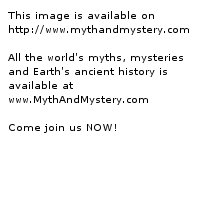
" PBS Airdate: February 13, 2001
His name is Yax K'uk Mo'. His spirit haunts this valley, deep in the rainforest of Honduras. He is the legendary founder of Copan, a Maya city mysteriously abandoned over 1000 years ago. For 400 years, his dynasty of Holy Lords rules a kingdom through hallucinogenic visions, ritual warfare and human sacrifice. If the legend of Yax K'uk Mo' is true, then scientists believe he must be buried here, beneath this massive temple pyramid. One-hundred-thirty feet down and 1600 years back in time, anthropologist Robert Sharer burrows deep into the pyramid, searching for the bones of Yax K'uk Mo'. After 10 years of excavating and tunneling, following lines left from plaster floors long ago buried, Sharer uncovers an immense underground temple. On a vibrantly colored stucco panel, carved with symbols only recently decoded, is the name of the legendary first king of Copan, Yax K'uk Mo'. If the legend of Yax K'uk Mo' is true, then scientists believe he must be buried here, beneath this massive temple pyramid. One-hundred-thirty feet down and 1600 years back in time, anthropologist Robert Sharer burrows deep into the pyramid, searching for the bones of Yax K'uk Mo'. After 10 years of excavating and tunneling, following lines left from plaster floors long ago buried, Sharer uncovers an immense underground temple. On a vibrantly colored stucco panel, carved with symbols only recently decoded, is the name of the legendary first king of Copan, Yax K'uk Mo'. To resurrect the voice of the Maya, scholars must overcome one of the most tragic losses in history—that of the Maya code. For centuries, the Maya created thousands of books made of bark and covered with hieroglyphs. But in the 1500s when the Spanish conquer Central America, the Spanish priests declare the strange books to be the work of the devil and burn them. A thousand years of knowledge and the key to understanding the Maya writing go up in smoke. One of the first things that was deciphered about 100 years ago was the calendar system. And I have an example of it here from an ancient Maya book, a facsimile of one, where we have an example of a date written with five numbers using bars and dots. That's the way Maya represented numbers between one and 19. A bar was a five, and a single dot was a one. So, if we look at this column for example, right here, we have five numbers, the top one being an eight, the next down is an eleven, then after that an eight, and a seven. And then this football-shaped sign is the way the ancient Maya wrote a zero sometimes. Their knowledge of the number system helped early scholars discover that the Maya books were celestial almanacs. The Maya could chart the 365-day solar cycle, predict solar and lunar eclipses, and even track the complex orbit of Venus. Amazingly, their Venus almanac is accurate to within two hours every 500 years. http://www.pbs.org/wgbh/nova/transcripts/2804maya.html
The Knowledge of the south Amerindians, they were advance in engineering and experienced in working in wet land conditions. To build a structure in a small wetland area would be a small task for them? (ie.) Birch Island Triangle it's contruction may be older than the money pit. To discredit them of the construction of the Oak Island enigma would be ignorance? there books were stupidly burnt out of ignorant behavior, if some ones don't understand they discredit or burn it?
PRESS HERE DONATED![]()
Sincere Thanks

First Nations Oak Island Researcher
Keith Ranville
keith_ranville@hotmail.com
UP TO DATE LEADING CANADIAN EXCLUSIVE OAK ISLAND MONEY PIT TREASURE MYSTERY TREASURE HUNTING NEWS/RESEARCH/DISCOVERIES/THEORIES

http://oakislandtreasurenewsarchives.blogspot.com/














